Table of Contents
How Much Money Is Really in Your Grease?
A clean gallon of fryer oil is worth 10 to 50 ¢ to restaurants this year, depending on quality, volume and zip code. National yellow grease benchmarks hovered between 33 ¢ and 45 ¢ per lb in late June 2025, giving us the strongest rebate window in two years. Collection companies like Grease Connections digitally sends every quarter, so the math shows up on your P&L with no spreadsheets required. When fryer drippings offset food cost spikes, cash flow stabilizes and kitchens can fund new filters or menu tests without touching capital budgets. National Waste reminds us the right program can “generate significant income” while cutting maintenance risk.

Rebate Mechanics 101: From Pickup to Payment
At its core, a rebate is a post sale incentive paid after you meet volume or quality terms. Most cooking oil agreements use tiered brackets: rise above 100 gal / month and your rate climbs 5 to 10%. Mopac publicly bases payouts on Jacobsen market data, seasonality and FFA scores, giving restaurants a transparent formula. Grease Connections follows the same open book model but adds a “cleanliness bonus” for oil under 10% FFA to encourage good fryer habits. Expect ACH or paper checks within 30 days of month end so your kitchen sees revenue while memories of last week’s fry rush are still warm.
Sharing One Bin Without Losing Your Share
Food court tenants often pour into a single outdoor tank. NW Biofuel notes that works if every stall uses sealed jugs and a spill proof central container. California regulators clarify responsibility is shared: property owners must provide compliant service, but each restaurant must participate and track volumes. Grease Connections installs QR coded dip sticks that log gallons per pour, so quarterly payouts reflect each kitchen’s real contribution, not a guess. If you run multiple concepts under one roof, link your accounts and we’ll itemize rebates by brand for cleaner bookkeeping.
The Contract Clauses That Protect or Shrink Your Check
Many collectors ask for exclusivity. A typical clause from American Grease & Septic locks restaurants in for two years and sets a renegotiation trigger when yellow grease prices fall below $0.25 / lb. Sirion’s legal analysis says exclusivity is fine if scope, term and escape pathways are crystal clear. Prefer flexibility? Negotiate a “most favored rate” rider: if spot prices rise 20%, your rebate floats automatically. Fastmarkets’ new ICE UCO futures contract makes that drift easy to verify. Finally, demand written quality testing rules so a disputed FFA reading doesn’t erase months of hard earned pennies.
| Incentive | Typical Bump | When It Applies |
|---|---|---|
| Cleanliness bonus | +$0.05 to 0.15 / gal | FFA < 10% |
| Volume tier | +5 to 8% | >100 gal / month |
| Market adjuster | Floats monthly | Linked to Jacobsen/ICE indices |
State Snapshot: Rules & Average 2025 Rebates
| State | Avg. Restaurant Rebate | Key Rule / Agency |
|---|---|---|
| Florida | $0.15 to 0.45 / gal | Containers must sit on impermeable pads; spills cleaned immediately (FL DEP). |
| Georgia | $0.15 to 0.40 / gal | Biofuel tax incentives keep demand high, supporting payouts. |
| New Jersey | $0.15 to 0.45 / gal | Generators must follow strict spec and record keeping. (NJ DEP). |
Florida statute 403.0741 also bans dumping grease back into interceptors and demands manifested disposal, so good paperwork isn’t optional.
Market Forces That Nudge Your Rate
USDA reports show crude soybean oil (UCO’s nearest substitute) running 53 to 56 ¢ / lb in Illinois, up 20% year on year. When veg oil futures spike, collectors bid harder for grease to feed biodiesel plants, lifting rebates within weeks. Fastmarkets confirms traders now hedge with ICE’s new UCO contract, giving restaurants a public yardstick rather than opaque quotes. Quality still wins the day: every extra gallon of water or crumb of bread can drop your check by two to six cents, easy money lost for leaving lids open.
Real World Wins: From Franchise to Food Court
Chick fil A diverted 637,000 gallons of fryer oil into renewable diesel in 2023 by standardizing safe transfer systems across 1,700 restaurants, proving scale multiplies both safety and revenue. In Miami’s Bayside Marketplace, a multi stall food court moved from messy buckets to a shared, locked tank; quarterly payouts rose 18% once collection data was digitized because theft dropped to near zero. According to Green Energy Biofuel, simply placing tamper proof lids can cut spill clean up calls by 72%.
Why Restaurants Choose Grease Connections
We’re the only used collection company with hubs in Jacksonville, Atlanta and Newark, letting us pay one unified, above market rebate across all three states. Our live dashboard ties every pick up to current ICE and Jacobsen indices, so you see pricing down to the cent without chasing a rep. Quarterly statements arrive in both PDF and QuickBooks ready CSV, easy to forward to your accountant. And because our trucks already service Miami, Savannah and Trenton, all it takes just one click when you’re ready to schedule pickup.

Quick Answers
How do we split money if two brands share one fryer? We meter each pour through your QR code and settle per gallon.
Can we quit if service slips? Yes, our contract includes a 30 day exit if response time exceeds 72 hours, unlike the two year auto renew many rivals impose.
Do I need special flooring in Florida? Yes, oil must sit on sealed concrete or asphalt by rule 62 710.201.
Next Steps
Ready to turn liquid waste into predictable revenue? Schedule your free pickup in Miami, Atlanta or Newark today.









